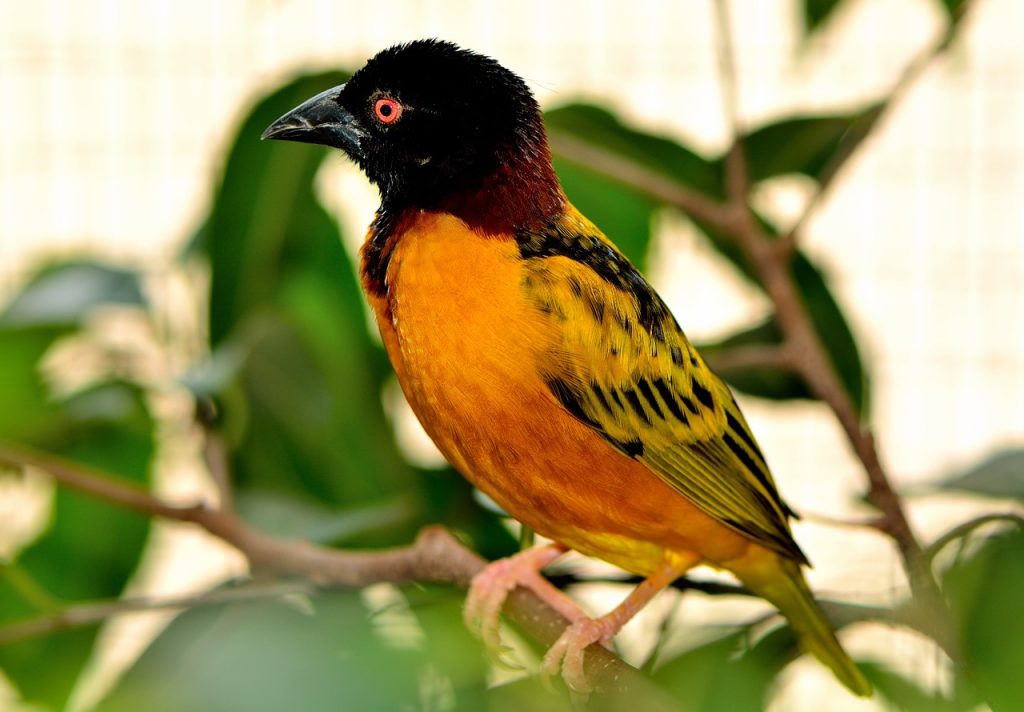
Weavers, what beautiful birds, especially during their frenetic breeding season. After molting, the males display their beautiful new colors, marking the start of an annual race to build intricate nests. They use their excellent weaving skills to create elaborate nests in the hope of attracting a mate.
Weavers are named after their beautifully woven nests. Their nests come in all different shapes and sizes, with each species having its own intricate architectural design. Amazingly, if you go to a colony of a specific species of weaver anywhere in the world, every nest is identical. However, not all weavers make tightly woven nests.
Habitat
Weavers inhabit diverse environments across South Africa, from the warm, dry west coast to the sub-tropical east coast. Their nest structures range from the enormous nests of the Sociable Weaver in the drier areas to the tightly woven nests of the Eastern Golden Weaver on the tropical east coast.
Weavers typically feed on insects, beetles, caterpillars, grasshoppers, larvae, seeds, some plants, and flowers, and occasionally spiders. Essentially, they forage for whatever is available in their environment.
Many of the “yellow” weavers’ nests are found close to bodies of water, hanging in trees, or attached to reeds. These nests are usually made from grass stems, reeds, or palm leaves. The males build these nests to attract females.
Home Selection
Females are very fussy and inspect the nests for sturdiness and robustness. If a nest is approved, the pair will start breeding once the female has lined the inside of the nest with grasses and soft foliage. If the nest fails to impress the female, the male will typically break it down and start rebuilding in the hope of future success.
In some species, the entrance length of the nest is increased only once the female has accepted it. She judges the male not by his looks but by his craftsmanship.
Weavers are generally gregarious with a typical staccato call described as ‘endless chattering.’ Their calls are unique to each species, and their songs can be quite captivating.
The Yellow Weavers
These first few species exhibit a unique courtship behavior where the males hang upside down, shaking their bodies and wings rapidly while calling to attract a mate.
Lesser Masked Weaver (Ploceus intermedius) Standing at 14 cm, the Lesser Masked Weaver has a black mask reaching the middle of its crown and pale eyes, distinguishing it from the Southern Masked Weaver with red eyes. They build tight, robust nests in large colonies in savannah and woodlands, preferring areas near water.
Eastern Golden (Yellow) Weaver (Ploceus subaureus) These beautiful birds, around 15 cm tall, display a golden yellow plumage with bright red eyes during the breeding season. They build tight, compact nests in reeds or trees near water, often with other weavers. These nests are oval-to-round with the opening facing downward but without a tunnel.
Cape Weaver (Ploceus capensis) Endemic to Southern Africa and larger than other weavers at about 17.5 cm, the Cape Weaver has a chestnut wash over its forehead and brown legs. They construct prominent, neatly kidney-shaped nests with a bottom-side entrance. These weavers often migrate during winter and return in spring.
Southern Masked Weaver (Ploceus velatus) At about 15 cm high, the Southern Masked Weaver has a black mask from its forehead to its upper breast and red eyes. They build tightly woven nests with an opening at the bottom, avoiding evergreen forests and preferring open scrub and savannah.
Spectacled Weaver (Ploceus ocularis) Standing at 15.5 cm, the Spectacled Weaver is primarily golden yellow with a black mask and pale yellow eyes. They build tightly woven, retort-shaped nests suspended from pendulous vegetation and are monogamous, with breeding pairs staying together for several consecutive years.
Holub’s Golden Weaver (Ploceus xanthops) Similar to the Eastern Golden Weaver but slightly larger at 17 cm with pale yellow eyes, Holub’s Golden Weaver has an olive green back and an untidy, kidney-shaped nest. They are uncommon residents in South Africa, typically found in well-wooded environments.
Weavers of Different Colors
Red-billed Buffalo Weaver (Bubalornis niger) These black weavers, standing 25 cm tall, have red bills and small white wing patches. They build bulky nests of thorny branches divided into chambers. Dominant males control more chambers and females, creating a polygynous social structure.
Dark-backed Weaver (Ploceus bicolor) A melodious bird with distinctive dark backs and yellow underparts, the Dark-backed Weaver builds untidy nests with long tunnels. They are monogamous and found in small groups in woodlands.
Red-headed Weaver (Anaplectes melanotis) With bright scarlet faces and white underparts, the Red-headed Weaver is unique in South Africa. They build rough, untidy nests from twigs and grass stems and are monogamous, calling females by hanging upside down and quivering their wings.
Sociable Weaver (Philetairus socius) Endemic to Southern Africa, Sociable Weavers build enormous nesting structures from grass in trees or on telephone poles, creating colonies of up to 500 birds. They are cooperative breeders, with each pair building their chamber within the colossal structure.
Thick-billed Weaver (Amblyospiza albifrons) Standing 18 cm tall, Thick-billed Weavers have dark brown plumage and heavy bills with white wing patches. They build large nests between bullrush reeds with an upper-side opening and are polygynous, attracting mates by slowly flapping their wings.
Conclusion
Weavers are fascinating birds with their exquisite looks, exceptional nest-building skills, and adaptability to diverse environments. Watching these birds during breeding season, with their vibrant colors and captivating calls, is a highlight for any birder.
With a little practice, it becomes easier to identify individual species and observe their distinctive behaviors. The ingenuity and energy of male weavers as they feverishly weave their nests to win the approval of rather particular females is a sight to behold.
